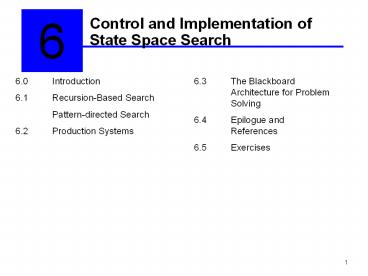Control%20and%20Implementation%20of%20State%20Space%20Search - PowerPoint PPT Presentation
Title:
Control%20and%20Implementation%20of%20State%20Space%20Search
Description:
Title: Ch. 6: Control Algorithms for State Space Search Author: Nilufer Onder Last modified by: Soner Onder Created Date: 8/22/1997 9:08:10 AM Document presentation ... – PowerPoint PPT presentation
Number of Views:388
Avg rating:3.0/5.0
Title: Control%20and%20Implementation%20of%20State%20Space%20Search
1
Control and Implementation of State Space Search
6
6.0 Introduction 6.1 Recursion-Based
Search Pattern-directed Search 6.2 Production
Systems
6.3 The Blackboard Architecture for
Problem Solving 6.4 Epilogue and
References 6.5 Exercises
2
Chapter Objectives
- Compare the recursive and iterative
implementations of the depth-first search
algorithm - Learn about pattern-directed search as a basis
for production systems - Learn the basics of production systems
- The agent model Has a problem, searches for a
solution, has different ways to model the search
3
Summary of previous chapters
- Representation of a problem solution as a path
from a start state to a goal - Systematic search of alternative paths
- Backtracking from failures
- Explicit records of states under consideration
- open list untried states
- closed lists to implement loop detection
- open list is a stack for DFS, a queue for BFS
4
Function depthsearch algorithm
5
Use recursion
- for clarity, compactness, and simplicity
- call the algorithm recursively for each child
- the open list is not needed anymore, activation
records take care of this - still use the closed list for loop detection
6
Function depthsearch (current_state) algorithm
7
Pattern-directed search
- use modus ponens on rules such as q(X) ? p(X)
- if p(a) is the original goal, after unification
on the above rule, the new subgoal is q(a)
8
(No Transcript)
9
A chess knights tour problem
Legal moves of a knight
Move rules
10
Examples
- Is there a move from 1 to 8?Pattern_search(move(
1,8)) success - Where can the knight move from
2?Pattern_search(move(2,X)) 7/X, 9/X - Can the knight move from 2 to 3?
Pattern_search(move(2,3)) fail - Where can the knight move from
5?Pattern_search(move(5,X)) fail
11
2 step moves
- ?X,Y path2(X,Y) ??Z move(X,Z) ? move(Z,Y)
- path2(1,3)?
- path2(2,Y)?
12
3 step moves
- ?X,Y path3(X,Y) ??Z,W move(X,Z) ? move(Z,W) ?
move(W,Y - path3(1,2)?
- path3(1,X)?
- path3(X,Y)?
13
General recursive rules
- ?X,Y path(X,Y) ??Z move(X,Z) ? path(Z,Y)
- ?X path(X,X)
14
Generalized pattern_search
- if the current goal is negatedcall
pattern_search with the goal and return success
if the call returns failure - if the current goal is a conjunctioncall
pattern_search for all the conjuncts - if the current goal is a disjunctioncall
pattern_search for all the disjuncts until one
returns success
15
A production system is defined by
- A set of production rules (aka
productions)condition-action pairs. - Working memory the current state of the world
- The recognize-act cycle the control structure
for a production system Initialize working
memory Match patterns to get the conflict set
(enabled rules) Select a rule from the conflict
set (conflict resolution) Fire the rule
16
A production system
17
Trace of a simple production system
18
The 8-puzzle as a production system
19
Production system search with loop detection
depth bound 5 (Nilsson, 1971)
20
A production system solution to the 3 ? 3
knights tour problem
21
The recursive path algorithm a production system
22
Data-driven search in a production system
23
Goal-driven search in a production system
24
Bidirectional search misses in both directions
excessive search
25
Bidirectional search meets in the middle
26
Advantages of production systems
Separation of knowledge and controlA natural
mapping onto state space searchModularity of
production rulesPattern-directed
controlOpportunities for heuristic control of
searchTracing and explanationLanguage
independenceA plausible model of human problem
solving
27
Comparing search models
- Given a start state and a goal state
- State space search keeps the current state in
a node. Children of a node are all the possible
ways an operator can be applied to a node - Pattern-directed search keeps the all the states
(start, goal, and current) as logic expressions.
Children of a node are all the possible ways of
using modus ponens. - Production systems keep the current state in
working memory. Children of the current state
are the results of all applicable productions.
28
Variations on a search theme
- Bidirectional search Start from both ends,
check for intersection (Sec. 5.3.3). - Depth-first with iterative deepening implement
depth first search using a depth-bound.
Iteratively increase this bound (Sec. 3.2.4). - Beam search keep only the best states in OPEN
in an attempt to control the space requirements
(Sec. 4.4). - Branch and bound search Generate paths one at a
time, use the best cost as a bound on future
paths, i.e., do not pursue a path if its cost
exceeds the best cost so far (Sec. 3.1.2).































